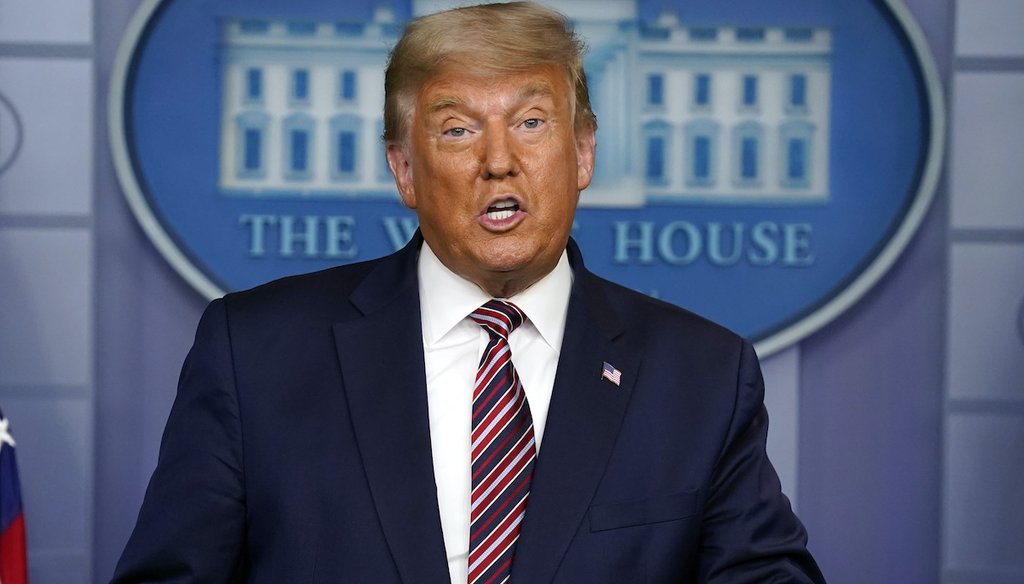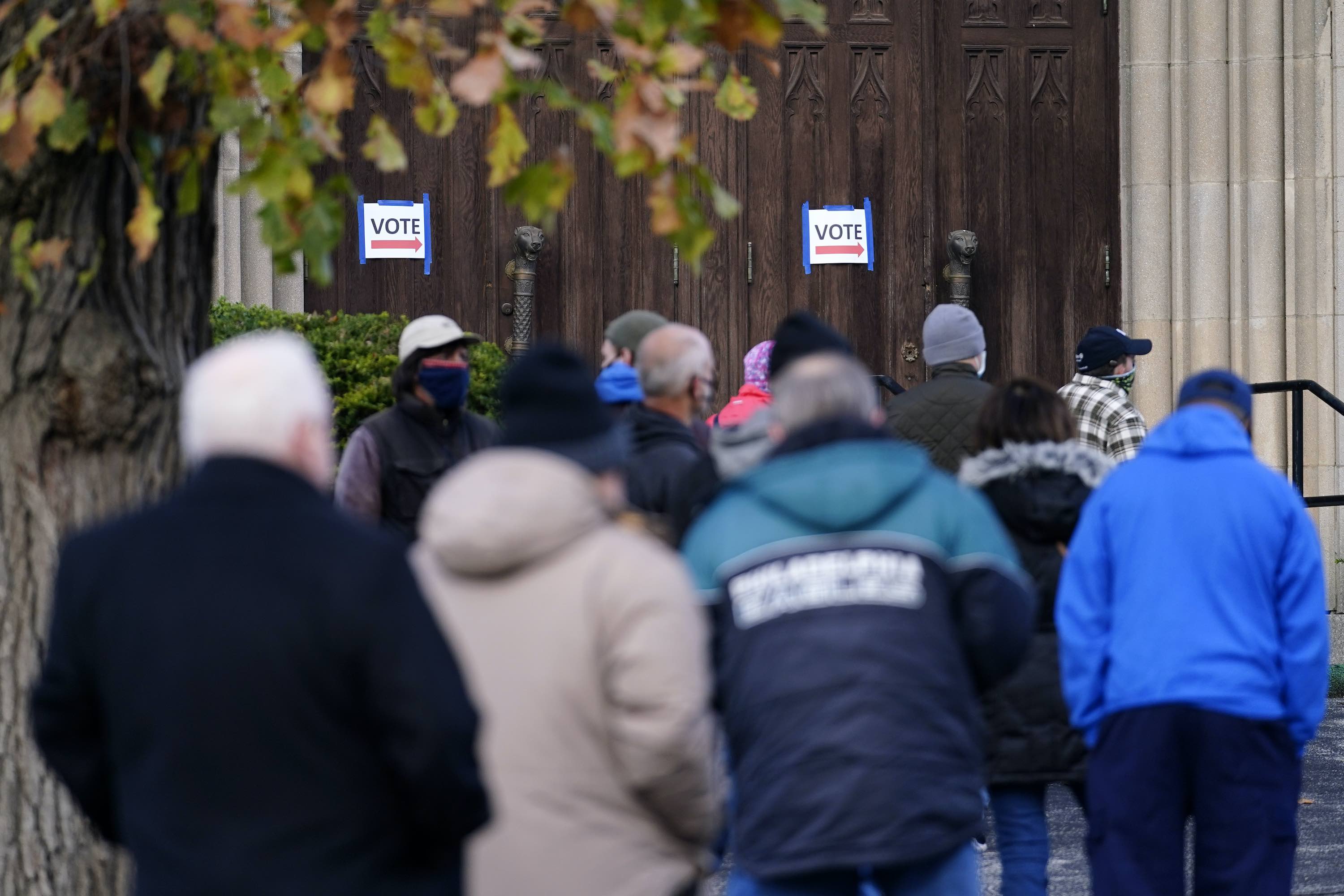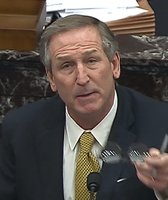Stand up for the facts!
Our only agenda is to publish the truth so you can be an informed participant in democracy.
We need your help.
I would like to contribute

President Donald Trump speaks at the White House on Nov. 5, 2020, in Washington. (AP)
If Your Time is short
-
Donald Trump, his re-election campaign and his adult sons have amplified and in some cases created misinformation about the ongoing vote count. His campaign recruited volunteers to watch for fraud at the polls in battleground states.
-
False claims of fraud in the ballot-counting process have inspired Trump supporters to demonstrate in battleground states that the president needs to win in order to retain the presidency.
-
Law enforcement agencies and social media companies have prepared for potential unrest inspired by delays in the vote count.
Since Election Day, social media users on nearly every major platform have spread rumors of discarded ballots, mysterious new votes and sudden halts in the vote-counting process to raise doubts about Democratic presidential nominee Joe Biden’s gains in battleground states.
Many of the rumors found a home in the social media accounts of President Donald Trump, his campaign and his family. Trump and his family have amplified false and misleading posts alleging voter fraud since the early morning hours of Nov. 4, despite the lack of any proven fraud or major errors in the ballot-counting process.
Trump has made baseless claims of voter fraud the centerpiece of his fight for re-election, and his campaign filed lawsuits in three states that raise concerns about absentee ballots and demand more access to ballot-counting centers.
"The most remarkable thing is simply how predictable the disinformation has been," said Rebekah Tromble, director of the Institute for Data, Democracy & Politics at George Washington University. "The Trump campaign telegraphed its strategy months in advance, making their response the last few days entirely predictable."
Less predictable was the speed with which Trump’s supporters took what they saw on their Facebook feeds and used it to organize in-person protests at ballot-counting facilities. On Nov. 4, demonstrators gathered at TCF Center in Detroit and urged election officials to "stop the count." A similar protest was planned at the Arizona Capitol building in Phoenix.
Some experts are concerned those gatherings could escalate as uncertainty about the presidential election continues — leading social media platforms to take steps that limit the potential for organized violence.
Ben Decker, founder and CEO of Memetica, a digital investigations firm, said he expects an increase in the charged rhetoric, and it could lead to harm and unrest offline.
"The granularities of what’s happening are too hard to explain in a meme, but the misinformation is easy to explain in a meme, and that’s the problem," Decker said.
Hours before polls closed, photos and videos of polling places in Pennsylvania proliferated on social media. The posts were somewhat benign, showing campaign signs, poll watchers and election workers handling ballots.
But the claims behind the posts alluded to a sinister plot.
"More scamming in Pennsylvania!" wrote Mike Coudrey, a self-described activist and entrepreneur, on Twitter alongside an image of a sign that blurs the names of Republican candidates in Bucks County, Pa.
The sign was a run-of-the-mill piece of electioneering material. Another post claimed an "unidentified civilian" was taking ballots away from a polling place when, in fact, the person in the image was an election worker.
The early emphasis on Pennsylvania wasn’t surprising, as the state’s 20 Electoral College votes play an important role in the path to the White House.
But there was something novel about the way this misinformation aimed to cast doubt on the legitimate voting process.
"The misinformation wasn’t about trying to suppress the vote on Election Day — it was much more about trying to undermine the integrity of the vote," said Claire Wardle, co-founder of First Draft, a nonprofit organization that tracks online misinformation. "It seems like it was creating a scaffolding for future lawsuits."
People wait outside a polling place to cast their ballots on Election Day on Nov. 3, 2020, in Media, Pa. (AP
In the lead-up to Election Day, Mike Roman, director of Election Day Operations for the Trump campaign, organized an army of volunteers to monitor voting in Democratic areas. The campaign said it had recruited 50,000 poll watchers nationwide and hired full-time staff in 11 battleground states to assist with the effort.
The result was a deluge of photos and videos that Trump supporters said showed evidence of widespread voter fraud.
In reality, the posts showed isolated problems with state elections systems that are already strained by historic turnout and the unprecedented number of votes by mail.
Posts with the hashtag #StopTheSteal were shared tens of thousands of times on Facebook, according to CrowdTangle, a social media insights tool. The hashtag, which pays homage to a similar movement led by former Trump associate Roger Stone in 2016, saw a significant bump on Nov. 4 when Trump’s lead started to shrink in battleground states.
As the Pennsylvania count wore on, the attention shifted to other battleground states that were still counting votes.
A viral social media rumor claimed that voters in Maricopa County, Ariz., were forced to fill in their ballots with Sharpie pens that would invalidate their votes. (Officials passed out Sharpies because they give more precise results.) Baseless allegations of voter fraud in Michigan, North Carolina and Wisconsin proliferated on Facebook and Twitter. Some Trump supporters claimed that election workers had stopped counting votes altogether in an effort to sway the election in favor of Biden.
RELATED: Fact-checking the avalanche of Wisconsin election misinformation
In several cases, Trump’s sons became drivers of viral misinformation. Eric Trump retweeted a video that falsely claimed to show someone burning a stack of 80 ballots cast for his father. On Facebook, Donald Trump Jr. used bad math to say turnout in Wisconsin had jumped more than 20% since 2016.
"Looks like fraud!" Eric Trump said in a similar post.
False claims of voter fraud have a long history in the Trump family. One month before Election Day in 2012, Donald Trump tweeted an ominous warning.
"’It doesn't matter who you vote for--it matters who is counting the votes,’" the billionaire wrote, citing a quote that is frequently misattributed to Joseph Stalin. "Be careful of voter fraud!"
To be clear: There is no evidence that voter fraud is widespread, in 2012 or in 2020. There have been a few confirmed cases over the past several years.
The spike of misinformation in states that are likely to decide who wins the election continues a trend that started well before Nov. 3. And while its intention is clearly to undermine confidence in the ballot-counting process, some experts say it’s too soon to tell what the effect will be as the weeks go on.
"I think that is working in some cases, but swift rebuke by other political actors, state election officials and the news media has tamped that down — as has action by the tech platforms to moderate it," said Shannon McGregor, a senior researcher at the Center for Information, Technology and Public Life at the University of North Carolina-Chapel Hill.
An election update in Clark County, Nev., was interrupted Nov. 4 by a man wearing a T-shirt that read, BBQ, beer, freedom. "The Biden crime family is stealing the election, the media is covering it up," the man shouted at the press conference.
The thin margins of the presidential race, the slow rollout of election results and online misinformation about the integrity of the vote have inspired Trump and Biden supporters alike to stake out ballot-processing centers nationwide.
By the evening on Nov. 4, demonstrations had cropped up in several cities. About 150 Trump supporters, some of them armed, gathered outside the Maricopa County recorder’s office in Phoenix to watch election workers count votes. Election officials in Detroit told dozens of challengers they could not enter a vote tally room at the TCF Center because it was over capacity.
"To them, they earnestly believe that democracy is being undermined, almost certainly because of things that they’ve read online and things that have been amplified by American officials," said Emerson Brooking, resident fellow at the Atlantic Council’s Digital Forensic Research Lab.
People in liberal cities gathered to protest Trump’s attempted intervention in the vote count. Some demonstrators in Minneapolis blocked a freeway, while others smashed shop windows in Portland.
Protesters hold letters that spell Count Every Vote as they cross an overpass while marching in Portland, Ore., on Nov. 4, 2020, following Tuesday's election. (AP)
The slow vote count in Pennsylvania, which expects to have "the overwhelming majority" of ballots counted by Nov. 6, could make it a hotspot for demonstrations over the weekend. National Guard troops are in 10 states — including Arizona, Georgia and Pennsylvania — in the event of demonstrations or violence.
Biden himself has urged his supporters to remain calm and simply wait for official counts to complete. "I ask people to stay calm. The process is working. The count is being completed. And we will know soon," he said on Nov. 5.
Social media platforms — where some demonstrators have organized in-person rallies — have prepared for unrest.
Most platforms have policies against content that incites people to violence. Twitter has put disclaimers on many tweets from Trump and his allies that preemptively declared victory in battleground states and promoted unconfirmed examples of voter fraud.
BuzzFeed News reported that, over the past week, Facebook has seen an increase in keywords that could incite people to violence. On Nov. 5, the company removed a group with more than 270,000 members that had become a source of misinformation about the vote count.
"In line with the exceptional measures that we are taking during this period of heightened tension, we have removed the Group 'Stop the Steal,' which was creating real-world events," a Facebook spokesperson told PolitiFact. "The group was organized around the delegitimization of the election process, and we saw worrying calls for violence from some members of the group."
Those actions could be too little, too late, given how quickly misinformation spreads and how easily users can form new groups. But some experts are optimistic.
"I think it's worth highlighting the relative calm that we have seen since Tuesday," Tromble said. "Despite the Trump campaign's attempts to sow doubt and stir unrest, the democratic process is functioning as it should."
Our Sources
The Army Times, "As ballot count continues, National Guard still activated in 10 states for possible civil unrest," Nov. 4, 2020
Associated Press, "Pennsylvania emerges as online misinformation hot spot," Nov. 4, 2020
Associated Press, "Trump ‘army’ of poll watchers led by veteran of fraud claims," Nov. 2, 2020
Associated Press, "Trump sues in 3 states, laying ground for contesting outcome," Nov. 5, 2020
BuzzFeed News, "Facebook Has An Internal Metric For "Violence And Incitement Trends." Right Now It’s Rising." Nov. 5, 2020
CNN, "Fact Check: Rudy Giuliani and Eric Trump's press conference was filled with false claims about ballots in Pennsylvania," Nov. 5, 2020
CrowdTangle, accessed Nov. 5, 2020
Detroit Free Press, "Michigan GOP lawyer alleges ballot misconduct at TCF Center in Detroit," Nov. 5, 2020
Email from a Facebook spokesperson, Nov. 5, 2020
Email from Rebekah Tromble, director of the Institute for Data, Democracy & Politics at George Washington University, Nov. 5, 2020
Email from Shannon McGregor, a senior researcher at the Center for Information, Technology, and Public Life at the University of North Carolina-Chapel Hill, Nov. 5, 2020
Facebook post from Eric Trump, Nov. 4, 2020
Factba.se, accessed Nov. 5, 2020
Fox News, "Police, security groups prepared for potential unrest as Election Day approaches"
Interview with Ben Decker, founder and CEO of Memetica, Nov. 5, 2020
Interview with Claire Wardle, co-founder of First Draft, Nov. 5, 2020
Interview with Emerson Brooking, resident fellow at the Atlantic Council’s Digital Forensic Research Lab, Nov. 5, 2020
NBC News, "Facebook anti-lockdown group mobilizes to drive people to vote-counting location in Detroit," Nov. 4, 2020
Newsweek, "'BBQ, Beer, Freedom' Man Who Said Biden's 'Stealing Election' in Viral Video Watched Over 10 Million Times," Nov. 5, 2020
The New York Times, "Battleground States See the Most Voting Misinformation," Nov. 2, 2020
The New York Times, "‘Count Every Vote’: Protests Over Ballot Tallies Sweep Through U.S. Cities," Nov. 5, 2020
The New York Times, "How Long Will Vote Counting Take? Estimates and Deadlines in All 50 States," Nov. 5, 2020
The New York Times, Nevada Election Results
The New York Times, "What’s Left in the States That Will Decide the Race," Nov. 4, 2020
PolitiFact, "Battleground states did not ‘stop counting’ votes on election night when Trump was ahead," Nov. 4, 2020
PolitiFact, "Eric Trump retweets video falsely claiming man burned 80 Trump ballots," Nov. 4, 2020
PolitiFact, "Fact-checking a misleading photo caption about a Philadelphia ballot box," Nov. 4, 2020
PolitiFact, "Fact-checking claim about poll watchers turned away in Philadelphia," Nov. 3, 2020
PolitiFact, "How Facebook, TikTok are addressing misinformation before Election Day," Oct. 19, 2020
PolitiFact, "No, ballots for Trump weren’t thrown out by a poll worker from Pennsylvania’s Erie County," Nov. 3, 2020
PolitiFact, "No, Biden did not receive thousands of mysteriously surfaced votes in Michigan," Nov. 4, 2020
PolitiFact, "No, Joseph Stalin didn't say this statement about elections," March 27, 2019
PolitiFact, "No, sign outside a Pennsylvania poll isn’t a voting scam," Nov. 4, 2020
PolitiFact, "No, these FiveThirtyEight graphs don’t prove voter fraud," Nov. 4, 2020
PolitiFact, "No, Wisconsin doesn’t have more ballots cast than registered voters," Nov. 4, 2020
PolitiFact, "No, Wisconsin voter turnout did not jump from 67% in 2016 to 89% in 2020," Nov. 5, 2020
PolitiFact, "North Carolina and Wisconsin did not have more votes cast than registered voters," Nov. 5, 2020
PolitiFact, "Sharpiegate, voter fraud claim in Arizona is False," Nov. 4, 2020
PolitiFact, "Social media post falsely claims Wisconsin 'found' 112,000 votes at 3 a.m.," Nov. 4, 2020
PolitiFact, "Trump’s cascade of falsehoods about voting by mail," Nov. 1, 2020
PolitiFact, "Trump falsely and prematurely claims 2020 presidential victory," Nov. 4, 2020
PolitiFact, "What you need to know about misinformation on Election Day," Nov. 2, 2020
PolitiFact Daily, "The avalanche of election misinformation"
ProPublica, "Federal Judge Issues Restraining Order Against Trump Campaign, Roger Stone," Nov. 5, 2016
Tweet from Donald Trump, Oct. 10, 2012
Tweet from Donald Trump, Nov. 4, 2020
The Verge, "Trump declares premature victories in battleground states on Twitter," Nov. 4, 2020
The Washington Post, "2020 turnout is on pace to break century-old records," Nov. 4, 2020
The Washington Post, "Trump and his allies boost bogus conspiracy theories in a bid to undermine vote count," Nov. 4, 2020
































